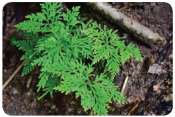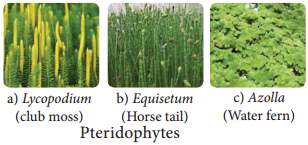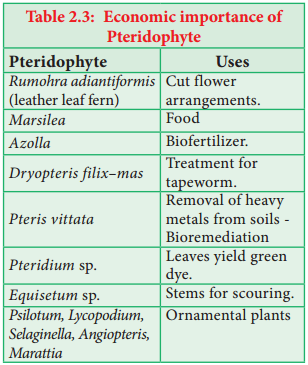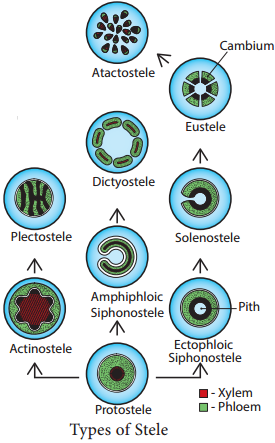Learninsta presents the core concepts of Biology with high-quality research papers and topical review articles.
Pteridophytes Types and its General Characteristic Features
Seedless Vascular Cryptogams
From the previous section, we are aware of the salient features of amphibious plants called bryophytes. But there is a plant group called pteridophytes which are considered as first true land plants. Further, they were the first plants to acquire vascular tissue namely xylem and phloem, hence called vascular cryptogams. Club moss, horsetails, quill worts, water ferns and tree ferns belong to this group. This chapter deals with the characteristic features of Pteridophytes.

Pteridophytes are the vascular cryptogams and were abundant in the Devonian period of Palaeozoic era (400 million years ago). These plants are mostly small, herbaceous and grow well in moist, cool and shady places where water is available. The photographs for some pteridophytes are given in Figure 2.6.

General Characteristic Features of Pteridophytes:
- Plant body is sporophyte (2n) and it is the dominant phase. It is differentiated into root, stem and leaves.
- Roots are adventitious.
- Stem shows monopodial or dichotomous branching.
- Leaves may be microphyllous or megaphyllous.
- Stele is protostele but in some forms siphonostele is present (Marsilea)
- Tracheids are the major water conducting elements but in Selaginella vessels are found.
- Sporangia, spore bearing bag like structures are borne on special leaves called sporophyll. The Sporophylls get organized to form cone or strobilus. Example: Selaginella, Equisetum.
- They may be homosporous (produce one type of spores-Lycopodium) or Heterosporous (produce two types of spores-Selaginella). Heterospory is the origin for seed habit.
- Development of sporangia may be eusporangiate (development of sporangium from group of initials) or leptosporangiate (development of sporangium from single initial).
- Spore mother cells undergo meiosis and produce spores (n).
- Spore germinates to produce haploid, multicellular green, cordate shaped independent gametophytes called prothallus.
- Fragmentation, resting buds, root tubers and adventitious buds help in vegetative reproduction.
- Sexual reproduction is oogamous. Sex organs, namely antheridium and archegonium are produced on the prothallus.
- Antheridium produces spirally coiled and multiflagellate antherozoids.
- Archegonium is flask shaped with broad venter and elongated narrow neck. The venter possesses egg or ovum and neck contain neck canal cells.
- Water is essential for fertilization. After fertilization a diploid zygote is formed and undergoes mitotic division to form embryo.
- Pteridophytes show apogamy and apospory.
Reimer (1954) proposed a classification for pteridophytes. In this classification, the pteridophytes are divided into five subdivisions.
- Psilophytopsida
- Psilotopsida
- Lycopsida
- Sphenopsida
- Pteropsida.
There are 19 orders and 48 families in the classification.
Economic Importance
The Economic importance of Pteridophyte is given in Table 2.3

Types of Stele
The term stele refers to the central cylinder of vascular tissues consisting of xylem, phloem, pericycle and sometimes medullary rays with pith (Figure 2.7).

There are two types of steles
- Protostele
- Siphonostele
1. Protostele:
In protostele phloem surrounds xylem. The type includes Haplostele, Actinostele, Plectostele, and Mixed protostele.
(i) Haplostele:
Xylem surrounded by phloem is known as haplostele. Example: Selaginella.
(ii) Actinostele:
Star shaped xylem core is surrounded by phloem is known as actinostele. Example: Lycopodium serratum.
(iii) Plectostele:
Xylem plates alternates with phloem plates. Example: Lycopodium clavatum.
(iv) Mixed prototostele:
Xylem groups uniformly scattered in the phloem. Example: Lycopodium cernuum.
2. Siphonostele:
In siphonostele xylem is surrounded by phloem with pith at the centre. It includes Ectophloic siphonostele, Amphiphloic siphonostele, Solenostele, Eustele, Atactostele and Polycylic stele.
(i) Ectophloic Siphonostele:
The phloem is restricted only on the external side of the xylem. Pith is in centre. Example: Osmunda.
(ii) Amphiphloic Siphonostele:
The phloem is present on both the sides of xylem. The pith is in the centre. Example: Marsilea.
(iii) Solenostele:
The stele is perforated at a place or places corresponding the origin of the leaf trace.
(a) Ectophloic Solenostele:
Pith is in the centre and the xylem is surrounded by phloem Example Osmunda.
(b) Amphiphloic solenostele:
Pith is in the centre and the phloem is present on both sides of the xylem. Example: Adiantum pedatum.
(c) Dictyostele:
The stele is separated into several vascular strands and each one is called meristele. Example: Adiantum capillus-veneris.
(iv) Eustele:
The stele is split into distinct collateral vascular bundles around the pith. Example: Dicot stem.
(v) Atactostele:
The stele is split into distinct collateral vascular bundles and are scattered in the ground tissue. Example: Monocot stem.
(vi) Polycyclicstele:
The vascular tissues are present in the form of two or more concentric cylinders. Example: Pteridium.